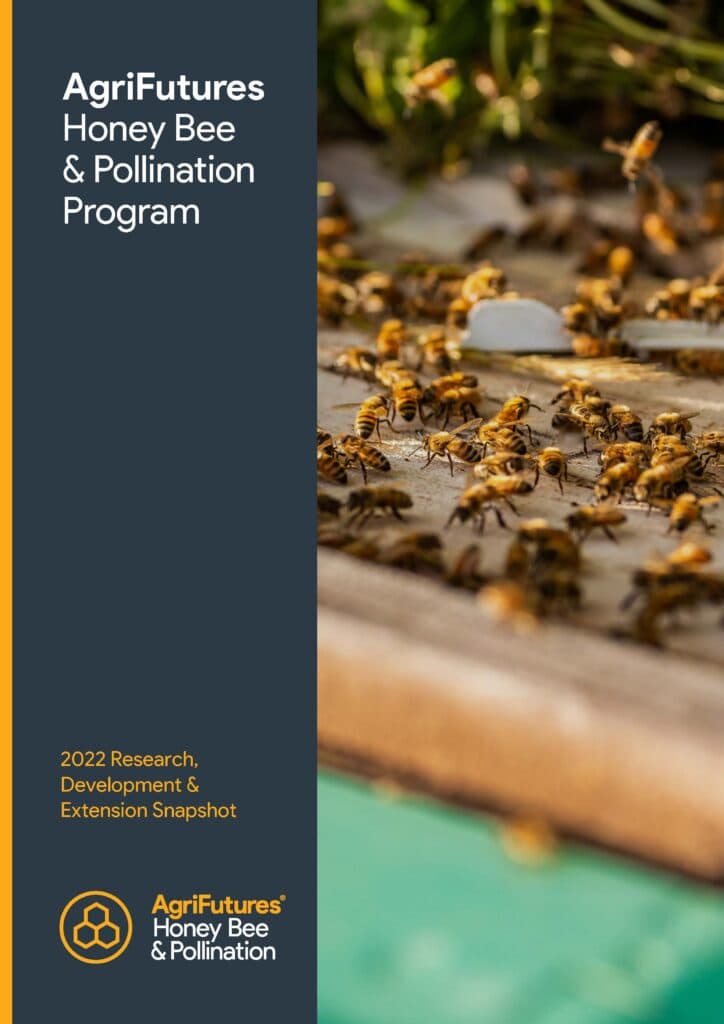Message from Annelies McGaw, Manager, Research of the AgriFutures Honey Bee & Pollination Program
As we approach midway point of the five-year AgriFutures Honey Bee & Pollination Program Strategic RD&E Plan (2020-2025), which guides the investment of our R&D levy allocation, it is thrilling to witness the scope and diversity of the projects it is enabling.
The Plan outlines six key objectives and each of our RD&E investments must address one or more of these objectives. It is reassuring, looking across the breadth of R&D activities covered in this Snapshot, to see such a comprehensive investment addressing the key issues Australia’s beekeepers face on a daily basis.
Identifying and developing new technologies to improve hive performance is one of the key objectives of the Strategic RD&E Plan. Several projects are looking to technology to solve a range of industry challenges. The recent completion of one of our Industry Development Grant projects, undertaken by Associate Professor Alan Dorin from Monash University, resulted in the development of multi-point monitoring technology, which could improve pollination outcomes and increase crop yields and product quality. This impressive monitoring system offers an invaluable insight into the natural tendencies and preferences of honey bees in undercover cropping situations, and has attracted the attention of some of Australia’s largest berry producers.
During the past 12 months, we have invested in several new projects that seek to improve the productivity of our bees and the health of our hives – another key objective of the current Strategic RD&E Plan. Projects such as ‘Setting honey bee nutrition minimum requirements and toxicity for Australian bee stock’ will ultimately lead to a healthier and more productive honey bee and pollination industry.
Similarly, we remain vigilant about pest incursions and reducing the incidence and impact of pests and diseases. Exciting progress has been made towards a cost-effective, user-friendly and robust portable device that could provide rapid and accurate American foulbrood (AFB) test results in the field. We continue to invest in research to better understand the complex relationship between Australia’s unique native flora and the honey bee, not only in terms of the health and productivity of our bees, but also the medicinal properties of a range of hive products, including honey, pollen and propolis. Building on knowledge gained from overseas studies, an exciting new project is assessing the neuroprotective compositions of the eastern Australian monofloral honey.
Our Industry Development Grants continue to be a fulfilling and flexible initiative within the Program. These grants allow us to respond quickly to a diverse range of industry needs and build the leadership, skills and knowledge needed to assure the ongoing resilience of the honey bee and pollination industries in Australia. As you read about the new grant recipients we have funded this year, I am sure you will be as excited as I am about the potential these projects offer the industry.
In this year’s Snapshot, we are again excited to showcase important work being done alongside the AgriFutures Honey Bee & Pollination Program, such as the Honey Bee Genetic Improvement Program (Plan Bee). The program has recently produced a ‘Getting started with genetic selection’ guide to complement the ‘Plan Bee Breeding Manual’. And in October 2021, the AgriFutures National Rural Issues Program released a report on biosecurity sensing technologies for select small and emerging industries. The report identified the key technologies that have the potential to protect Australia’s honey bee and pollination industry from biosecurity threats.
Currently, Australian native bee honey production has an estimated industry value of less than $1 million. By 2030, however, this value is expected to increase to $3-5 million, with native bee honey retailing for $200-450 per kilogram. We share a high-level overview of the Australian Native Bee Strategic RD&E Plan (2022-2027) and take a look at a project that investigated the bioactive content of Australian stingless bee honey.
Finally, it is a pleasure to welcome Professor Ben Oldroyd onto our Advisory Panel this year. His leadership and guidance as Chair will be much appreciated as we enter the final years of the current Strategic RD&E Plan. Ben’s wealth of experience from both a practical beekeeping perspective and his years of research into honey bee genetics offer an invaluable opportunity the Program is fortunate to be able to harness.
Our focus is to ensure we deliver for commercial beekeepers. We prioritise and make recommendations for RD&E investment that will benefit the industry and ensure it is positioned strongly for growth and prosperity. The combination of adaptable beekeepers and innovative research means the future looks bright for Australia’s honey bee and pollination industry.





